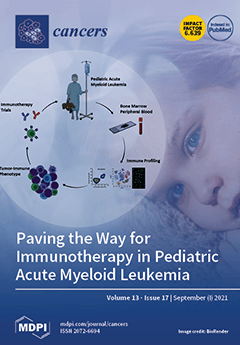The human UDP-glycosyltransferase (UGTs) superfamily has 22 functional enzymes that play a critical role in the metabolism of small lipophilic compounds, including carcinogens, drugs, steroids, lipids, fatty acids, and bile acids. The expression profiles of
UGT genes in human cancers and their impact
[...] Read more.
The human UDP-glycosyltransferase (UGTs) superfamily has 22 functional enzymes that play a critical role in the metabolism of small lipophilic compounds, including carcinogens, drugs, steroids, lipids, fatty acids, and bile acids. The expression profiles of
UGT genes in human cancers and their impact on cancer patient survival remains to be systematically investigated. In the present study, a comprehensive analysis of the RNAseq and clinical datasets of 9514 patients from 33 different TCGA (the Genome Cancer Atlas) cancers demonstrated cancer-specific UGT expression profiles with high interindividual variability among and within individual cancers. Notably, cancers derived from drug metabolizing tissues (liver, kidney, gut, pancreas) expressed the largest number of
UGT genes (COAD, KIRC, KIRP, LIHC, PAAD); six
UGT genes (
1A6,
1A9,
1A10,
2A3,
2B7,
UGT8) showed high expression in five or more different cancers. Kaplan–Meier plots and logrank tests revealed that six
UGT genes were significantly associated with increased overall survival (OS) rates [
UGT1A1 (LUSC),
UGT1A6 (ACC),
UGT1A7 (ACC),
UGT2A3 (KIRC),
UGT2B15 (BLCA, SKCM)] or decreased OS rates [
UGT2B15 (LGG),
UGT8 (UVM)] in specific cancers. Finally, differential expression analysis of 611 patients from 12 TCGA cancers identified 16
UGT genes (
1A1,
1A3,
1A6,
1A7,
1A8,
1A9,
1A10,
2A1,
2A3,
2B4,
2B7,
2B11,
2B15,
3A1,
3A2,
UGT8) that were up/downregulated in at least one cancer relative to normal tissues. In conclusion, our data show widespread expression of
UGT genes in cancers, highlighting the capacity for intratumoural drug metabolism through the UGT conjugation pathway. The data also suggests the potentials for specific
UGT genes to serve as prognostic biomarkers or therapeutic targets in cancers.
Full article






